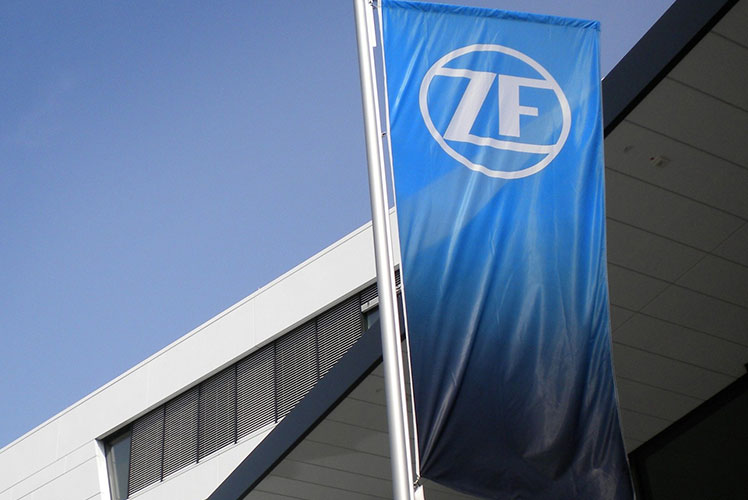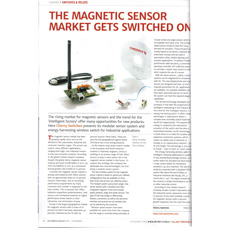CHERRY presents modular sensor system and energy harvesting wireless switch
The magnetic sensor market has been growing rapidly since 2010 as the demand in the automotive, industrial and consumer markets surges. The sensors are used in many different applications, ranging from high-cost industrial motors to low cost consumer products. According to the global market research company iSuppli, the global silicon magnetic sensor revenue will reach €9.88 billion in 2017, up from €4.63billion in 2011 at a compound annual growth rate (CAGR) of 12%.
Currently the magnetic sensor market is already dominated by hall-effect sensors with an approximate share of 70% (source: Panel Data). Due to increasing performance requirements by many customers this number is supposed to rise even further. This is because hall-effect solutions outperform potentiometers, reed sensors and mechanical switches at higher performance levels thanks to their robustness and elimination of wear. Europe is the largest geographical market for magnetic sensors with a share of 61% (of which Germany represents 43%), followed by the US with 39% (source: Panel Data). These are also the two geographical regions where ZF/CHERRY has a very strong presence.
CHERRY’s background in the automotive sector prior to its acquisition by ZF in 2008 means that there is significant engineering expertise and know-how to support new product developments. As the mature snap action switch market in the European and North American markets is relatively stagnant, CHERRY is building on its proven range of hall-effect sensors to play a more active role in the magnetic sensor market in the future. To support this strategy, the company has developed two new technologies, the first being a modular sensor system.
The new modular system for the magnetic sensor market is based on several pre-defined configurations that are available on short lead-times and at very cost-effective prices. The modular system uses proven single-chip sensor devices with a standard and fully-integrated magnetic circuit and includes speed, position, angle and stroke sensors. The type of hall chip (single or differential), fixation, connection, as well as the electronic interface and protocol are all variables that can be selected by the customer.
Modular speed sensors have been available for some time from CHERRY but the range is currently being extended, to include stroke and angle sensors which will be available from early 2015. The recently added sensor products meet the rising demand for actuators. Those actuators are mostly based on an electric, hydraulic and pneumatic concept and are used in automation, drive, vehicle steering and actuator applications. To achieve a better performance with actuators, a conventional open-loop controller isn’t sufficient anymore as normally a closed-loop control is created which requires the use of a sensor.
The stroke and angle sensors benefit from small package sizes, so they can be used in very small spaces. The operating temperature range is -40 up to +150 degrees Celsius and meets the minimum IP67 rating. Angle sensors are freely programmable from 0° to 360°. The freely programmable measuring range for the displacement sensors ranges from 5mm up to 45mm. A special version with a measuring range of 25mm for electric and hydraulic drives is available now.
With sensors from CHERRY, safety-critical systems can be engineered in compliance with SIL. The new displacement and angle sensors are designed and built, so that the required parameters for SIL-applications are available. For example reliability values have been optimized and are on hand. Also, the system can have the required diagnosis capabilities. Furthermore, all sensors are also available in dual output versions where redundancy safety solutions are needed.
The second technology developed by CHERRY in line with the progression of intelligent networking in the industry and the trend for the ‘intelligent factory’, is the energy harvesting switch. It offers many advantages in applications where a complex wire assembly and/or batteries would be inappropriate. The required RF-energy is created by the mechanical actuation of the switch and the data is transmitted wireless via RF-technology. As a result there is no need for complex and expensive connection systems, which means no cables and no batteries to change so no maintenance required – just fit and forget. The technology is very easy to install – even in hard-to-reach places.
The energy harvesting wireless switch for intelligent industrial applications is available in two standardised package versions: as a rocker switch for actuation by hand and as a snap-action switch for mechanical actuation, e.g. by a machine. The switch can easily be connected with a standard SPS bus system like OpenCAN and Profibus or industrial interfaces like RS485, SPI, 4-20mA and 0-24V. The signal received by the receiver is simply transmitted to an SPS or other industrial control.
With a strong customer base in the Industrial and non-Automotive sectors (e.g. Process Control, Recreation Vehicles, Off-Road Vehicles, Construction and Agricultural Vehicles, as well as Wind Power Plants and Medical), CHERRY is well positioned to promote its new sensor and RF technology solutions. According to the market research company Etudes Conseil Corporation only the Industrial sector represents more than 10% of the total available market for magnetic sensors with 9% growth expected over the next five years.
For more information about CHERRY sensors click here









